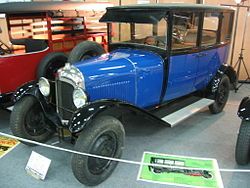Citroën type B10
| Citroën | |
|---|---|
|
Citroën type B10
|
|
| Type B10 | |
| Production period: | 1924-1925 |
| Class : | Middle class |
| Body versions : | Touring car , limousine |
| Engines: |
Otto engine : 1.5 liters (15 kW) |
| Length: | 3680-4000 mm |
| Width: | 1350 mm |
| Height: | |
| Wheelbase : | 2830 mm |
| Empty weight : | 810 kg |
| Previous model | Citroën type B2 |
| successor | Citroën type B12 |
The Citroën Type B10 replaced the sedan of the Citroën Type B2 in 1924 . It was essentially a type B2, but it was the first passenger car in Europe to have a body made entirely of steel .
The B10 was the first car in Europe that was largely produced on an assembly line . Like the B2, it was powered by a 4-cylinder gasoline engine via an unsynchronized 3-speed manual transmission. The engine made 20 HP with 1452 cm³ displacement. The top speed dropped slightly to 70 instead of 72 km / h. The starting price was 25,000 francs . At the beginning of 1925, the torpedo followed with an all-steel body, which increased the price from 18,000 francs with a wooden frame to 19,000 francs.
A total of 17,259 copies of the B10 had been produced by 1925 and the series was then replaced by the improved Citroën B12 .
All-steel body
Until the appearance of the B10 by Citroën in 1924, bodies (exceptions for one-offs or small series) were made in the manner of coach construction with a wooden frame adapted to the body shape, either from ash or beech. On the outside of the wooden frame, both inside and outside of the body, sheets of steel were nailed on, which, however, did not protect the frame, in particular, but also the inside from the weather. At the beginning of production of the B10, the bending of the material did not work optimally, so that the frames warped a little shortly after the start of the journey and, for example, the doors sometimes opened by themselves. That was detrimental to Citroën's reputation. The chassis taken over from the B2 was improved with steel reinforcements within a short time until the problems were overcome. To make you forget these initial difficulties, the B10 was replaced by the B12 after just one year of construction.
André Citroën got the idea for the all-steel body from the American engineer Edward Gowen Budd , with whom he entered into a business relationship in 1923 and commissioned him to design all-steel bodies for Citroën and to set up and monitor production. In 1899, Budd began developing all-steel bodies for railroad cars before designing and producing all-steel bodies for automakers, particularly Pullman bodies. Dodge was the first major automaker in North America to work with Budd. With the Citroën B10, there was now an opportunity in Europe to make its development better known.
Flat thin sheets of steel are structurally weak and malleable, but when they are formed into a three-dimensional shape by deep drawing under pressure, the result is much greater rigidity. By welding these three-dimensional sheet metal to form hollow profiles, vehicle bodies could be made much stiffer, stronger and lighter than a body made of wood and sheet steel. The lower mass resulted in higher acceleration and lower fuel consumption. On the other hand, heavy and expensive presses were required for production.
In Germany, this led to many car manufacturers commissioning their bodies from Ambi-Budd in Berlin , the body shop built by Budd. Regardless of whether the bodies were obtained from a body shop or, as with Citroën, manufactured in-house, further high investments in tools were necessary in order to be able to attach the individual body parts typical of the vehicle. But after all these investments had been made, the vehicles could be produced faster and cheaper than using the "carriage building method".
While daily production at Citroën was 200 vehicles per day in 1924, it rose to 400 per day in 1928, when all models had all-steel bodies, accounting for 30% of the cars produced in France at the time. The challenge of the new production method in the initial investment concerned not only the car manufacturers, but also their banks and other investors, since most of the manufacturers were not independent. For most models, the costs only paid for themselves after a production period of five years or more. At the same time, the burden of the possible financing of the machines had to be absorbed. The technology also improved at the same time, so that earlier model changes took place at the mass manufacturers. In the later 1920s and early 1930s, the leading automobile manufacturers were therefore able to gain market share in the volume sector, while smaller competitors had to cease operations.
The changeover also led to financial problems at Citroën, although or precisely because Citroën was the first car manufacturer in Europe to build all-steel bodies. The high costs of developing and launching the Citroën Traction Avant with its self-supporting body led Citroën to bankruptcy. The company was taken over by Michelin .
literature
- Jacques Wolgensinger, André Citroën, Lupetti, ISBN 88-85838-69-3
- JP Foucault, Le 90 ans de Citroën, Éditions Michel Lafon, ISBN 978-2-7499-1088-8

